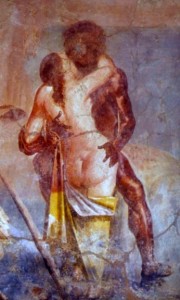Magnusne culus meus in hac videtur?
‘Does my bottom look big in this?’
A first century Roman woman would have asked this question hoping for the answer maximē! (You bet!)
Ideals of female beauty have always varied throughout the centuries, from the well-padded women of Rubens’ time to the androgynous flappers of the 1920’s to the late 20th century Playboy centerfold with big breasts and slender thighs. So it should come as no surprise that Romans of the first century AD had their own ideas of beauty.
The first thing you notice when looking at Roman female nudes is the number of nymphs and goddesses with small bosoms. “I fear big-breasted women”, wrote the first century poet Martial (14.66). Yes, he was a notorious woman-hater and yes, he was writing this from the point of view of an item of clothing, but in another epigram (14.134) he reminds us that the perfect breast could be cupped in a hand.
His attitude is reflected in surviving frescoes from the first centuries BC and CE.
Flip through any glossy book about Pompeii, or do a Google image search for Roman-fresco-nudes, and you will see that the women (goddesses mostly) almost always have small breasts, but generous rumps and thighs. In the notorious room of the Archaeological Museum of Naples called the Gabinetto Segreto or “Secret Cabinet” – where you find the most erotic Roman art – you will see that the sexiest women have the biggest bottoms.
Another erotic element of the ideal Roman woman is her pale skin. The contrast between the tanned body of a man (or giant) the milky skin of a woman (or nymph) created an erotic frisson. At the top of this post is an extremely sexy fresco of the one-eyed giant Polyphemus embracing the nymph Galatea.
Does her bottom look big in that? Maximē!
Another erotic work of the first century AD – a literary one this time – describes the face of an ideal woman. As my free translation of Satyricon 126 below shows, Petronius’ paradigm of female loveliness has a low forehead, aquiline nose and monobrow.
No speech could describe her beauty; whatever I say would be less than the whole. Her naturally curly hair springs from a narrow forehead to flow tumbling back over her shoulders. Her eyebrows run right from the edges of her cheekbones and almost meet above her eyes. And what eyes! They are brighter than stars sparkling in a moonless night. Her nose is slightly hooked and her little mouth as kissable as Praxiteles’ Diana. She outshines the whitest marble with the milky brightness of her chin, her neck, her hand, even her foot in its gilded sandal. (Satyricon 126.15ff)
Pasty skin, low forehead, strong nose, monobrow, small breasts, big bottom… These were the ideals of female beauty in first century Rome!
But in any age or era, the most discerning lovers will always look beyond surface to inner beauty. The famous love-poet Catullus is such a one when he dismisses the superficially beautiful Quintia in favour of his vivacious girlfriend Lesbia.
Everybody thinks Quintia is a beauty. I admit she is fair of skin and tall with graceful carriage. But I wouldn’t call her “beautiful”. She is not a bit sexy, doesn’t have a grain of wit in her whole statuesque body. Now Lesbia, she’s beautiful, and so amazing that she strips every bit of sexiness from every other woman. (Catullus 86)
The moral of the story is a timeless one. Don’t worry about whether you meet the ever-changing requirements for physical attractiveness, but find lovers and friends who will appreciate your inner beauty.
Caroline Lawrence writes Roman adventures for children aged 7 – 14, so was glad of the opportunity to talk about a subject she usually doesn’t tackle in schools.

